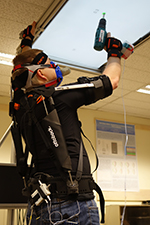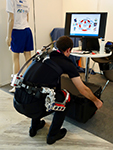Special Issue on Wearable Robotics
Call for Papers

Wearable robots have the potential to improve our lives in countless ways. People with weakened limbs can use exoskeletons to augment their strength or to retrain lost motor abilities, thus allowing them to nonetheless successfully perform activities of daily living. Similarly, workers of the future could use wearable robots to manipulate bigger and heavier loads, avoid injuries, and receive augmented feedback to enhance performance. Finally, wearable robots could even be used in sports, allowing wearers to move faster and farther.
Unfortunately, despite extensive research in this area, most wearable robots remain limited to controlled laboratory conditions. This is due to several reasons: insufficiently robust mechanical design and control, excessive weight or power consumption, insufficient evaluations with human subjects, unclear cost-effectiveness and other issues. However, these barriers are not insurmountable, and there are many opportunities for innovative solutions from research groups worldwide.
This special issue aims to bring wearable robots closer to broad real-world adoption by highlighting the latest innovations in the development of robust, intelligent wearable robots and their evaluations in real-world scenarios. It will focus on papers about working systems that are ideally evaluated with human subjects in order to determine the technology’s practical potential and impact on people with disabilities, workers, sportsmen, and others. Papers on stationary wearable robots will not be considered, though papers may be accepted if they describe the transfer of knowledge from stationary to wearable robotic technologies.

Papers should follow the standard RAM guidelines. A full peer-review process will be utilized to select papers for the special issue. Submissions should be made through the RAM submission website by 1 May 2019.This special issue aims to bring wearable robots closer to broad real-world adoption by highlighting the latest innovations in the development of robust, intelligent wearable robots and their evaluations in real-world scenarios. It will focus on papers about working systems that are ideally evaluated with human subjects in order to determine the technology’s practical potential and impact on people with disabilities, workers, sportsmen, and others. Papers on stationary wearable robots will not be considered, though papers may be accepted if they describe the transfer of knowledge from stationary to wearable robotic technologies.
***The above photos are from the GEs’ wearable robotics work that can be used as part of the call for papers. One is from the An.Dy project (http://andy-project.eu/) while the other is from the SPEXOR project (http://www.spexor.eu/).
Topics of Interest
- Mechanical design of robust wearable robots
- Collaborative control strategies for such wearable robots
- Reducing power consumption in wearable robots
- Human subjects evaluations of existing wearable robots in lab and real-world settings
- Human factors issues in real-world scenarios
- Impact of wearable robots on human productivity and quality of life
- Lessons learned when transferring wearable robots to different applications
- Cost-benefit analyses of wearable robots
Important Dates
March 2019 - Call for papers
1 May 2019 - Submission deadline
1 August 2019 - First decisions on manuscripts
November 2019 - Final decisions on manuscripts
December 2019 - Final manuscripts uploaded
March 2020 - Publication
Guest Editors

Ljubljana, Slovenia

Laramie (WY), USA

Brussels, Belgium







